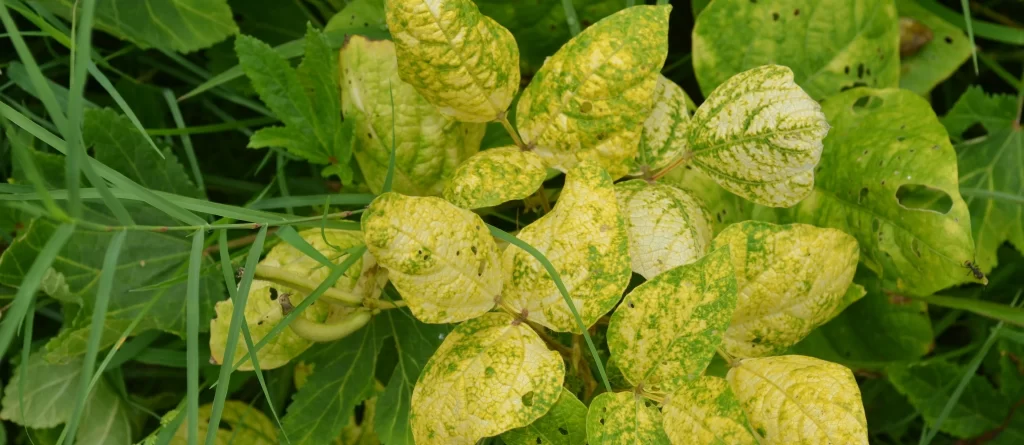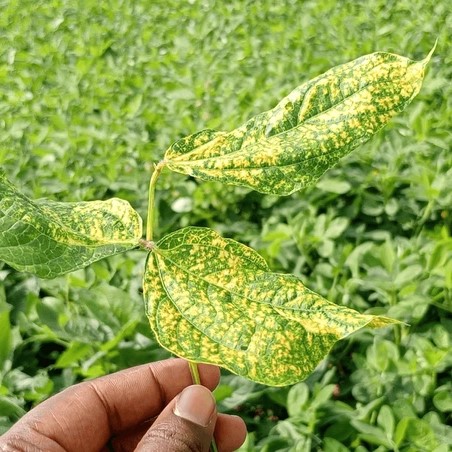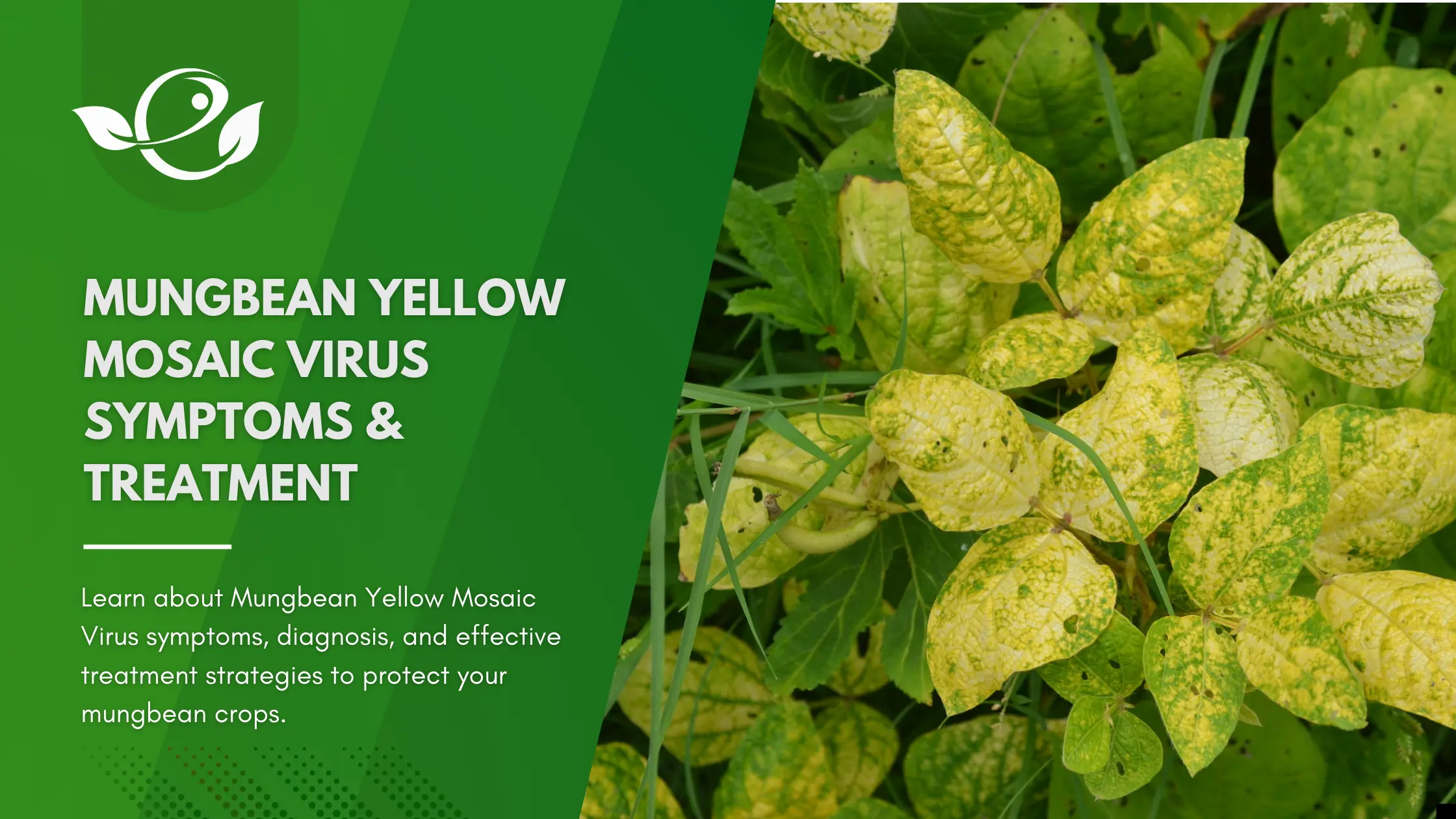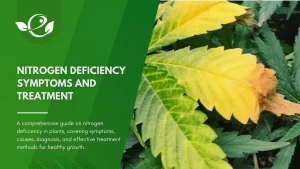Table of Contents
Mungbean, also known as Vigna radiata, is a vital crop in many parts of the world. It is celebrated for its high nutritional value, being rich in protein, vitamins, and minerals. Mungbean is a staple in various cuisines and an important source of income for farmers. However, this valuable crop is susceptible to several diseases, one of the most damaging being the Mungbean Yellow Mosaic Virus (MYMV).
Mungbean Yellow Mosaic Virus is a significant threat to mungbean cultivation. This disease can drastically reduce yield, affecting both the quality and quantity of the harvest. Understanding the symptoms and treatment of yellow mosaic virus is crucial for farmers and agricultural professionals to manage this disease effectively and ensure healthy crops.
Understanding Mungbean Yellow Mosaic Virus
What is MYMV?
Mungbean Yellow Mosaic Virus (MYMV) is caused by a begomovirus, a type of virus transmitted primarily by whiteflies. This virus affects various legumes, but mungbean is particularly vulnerable. Once a plant is infected, the virus spreads quickly, leading to a range of symptoms that can devastate crops if not managed promptly.

What caused it?
The virus is transmitted by the whitefly Bemisia tabaci. No seed transmission is possible. The disease occurs in a number of countries in Asia and in Australia. The yellow patches on the leaves considerably reduce plant productivity. Warm temperatures and high humidity favor vector populations. Infection with Mungbean Yellow Mosaic Virus can result in yield losses of up to 100%. The gram yellow mosaic virus affects black gram more often than green gram.
Geographic Distribution
MYMV is prevalent in many regions where mungbean is cultivated, including Asia, Africa, and the Indian subcontinent. The spread of yellow mosaic virus is influenced by environmental factors such as temperature, humidity, and the presence of whitefly populations. Regions with warm climates and dense whitefly populations are particularly at risk.
Can also be found in
Bean, Chickpea & Gram, Black & Green Gram, Pigeon Pea & Red Gram, Soybean
Symptoms of Mungbean Yellow Mosaic Virus
Recognizing the symptoms of MYMV is the first step in managing the disease. Early detection allows for prompt intervention, which can mitigate the damage and prevent further spread.
- Younger leaves may lose their green color (chlorosis), curl downwards or become papery white.
- Older leaves show scattered yellow specks that later develop into irregularly shaped green and yellow patches.
- The green areas are slightly raised, giving the leaf a puckered appearance.
- The lesions enlarge and coalesce, and start to die (necrosis).
- The growth of affected plants is stunted. They produce fewer flowers and pods. Their pods are small, thin and mottled, and sometimes curl upwards. They also contain fewer and smaller seeds.
Early Signs of Infection
The early signs of MYMV infection can be subtle but are crucial for early detection and management. Initially, infected plants exhibit chlorotic spots on the leaves, often starting near the leaf veins. These spots gradually expand and coalesce, leading to a distinct yellowing of the leaf veins.
Progressive Symptoms
As the infection progresses, the symptoms become more pronounced. The leaves develop a characteristic yellow mosaic pattern, with patches of yellow and green interspersed across the leaf surface. Infected leaves may also exhibit curling and deformation, reducing the photosynthetic efficiency of the plant. Additionally, the growth of the plant becomes stunted, resulting in shorter internodes and overall reduced plant vigor.
Advanced Symptoms
In advanced stages of MYMV infection, the entire leaf surface may be covered with a severe yellow mosaic pattern. The affected leaves often curl upwards and become brittle. Premature leaf drop is common, further reducing the plant’s photosynthetic capacity. The formation of pods is significantly affected, leading to reduced yields and poor seed quality.
Visual Examples and Descriptions
To aid in the identification of MYMV, visual examples are essential. Below are descriptions and images of infected plants at various stages:
Detailed Symptom Progression Timeline:
| Stage | Symptoms |
|---|---|
| Early | Chlorotic spots near leaf veins, slight yellowing |
| Progressive | Yellow mosaic pattern, leaf curling, stunted growth |
| Advanced | Severe yellowing, entire leaves affected, premature leaf drop, reduced pod formation |



Diagnosis of MYMV
Accurate diagnosis is essential for effective management of MYMV. Both field and laboratory methods are used to confirm the presence of the virus.
Field Diagnosis
Field diagnosis involves visual inspection and symptom recognition. Experienced farmers and agricultural professionals can often distinguish yellow mosaic virus from other conditions such as nutrient deficiencies or other viral infections by examining the characteristic symptoms.
Laboratory Diagnosis
For definitive diagnosis, laboratory tests are recommended. Several techniques are available:
- Serological Tests (e.g., ELISA): Enzyme-linked immunosorbent assay (ELISA) is a widely used method for detecting viral antigens in plant tissues. It is relatively quick and cost-effective, making it suitable for routine diagnostics.
- Molecular Techniques (e.g., PCR): Polymerase chain reaction (PCR) is a highly sensitive method for detecting viral DNA. It can confirm the presence of MYMV with high specificity and is useful for early detection and monitoring.
Accurate diagnosis is crucial for implementing effective management strategies and preventing the spread of MYMV.
Preventive Measures
- Plant-resistant varieties if available in your country. Developing and planting MYMV-resistant mungbean varieties is one of the most effective preventive measures. Researchers have made significant progress in breeding resistant varieties. Using these cultivars can greatly reduce the incidence of yellow mosaic virus in mungbean crops.
- Grow sorghum, maize or pearl millet around your field as border crops.
- Regularly check the field for symptoms and remove infected plants.
- Use yellow sticky traps to monitor or mass-catch the flies.
- Crop Rotation and Diversification: Crop rotation is a traditional and effective method to manage MYMV. Rotating mungbean with non-host crops breaks the lifecycle of the virus and reduces the risk of infection. Recommended rotation crops include cereals and other non-leguminous plants.
- Field Sanitation and Hygiene: Maintaining field hygiene is essential to prevent the spread of MYMV. Removing infected plant debris and controlling weeds that can harbor whiteflies are important steps. Ensuring clean fields minimizes the chances of virus transmission.
Organic Control of Mungbean yellow mosaic virus
No biological measure can be taken to control this viral disease. However, plant extracts such as neem oils are effective in reducing the population of whiteflies and improving the yield of the infected crops.
Chemical Control of Mungbean yellow mosaic virus
Always consider an integrated approach with preventive measures and biological treatments if available. Foliar sprays with cypermethrin, deltamethrin, or dimethoate can reduce whitefly populations. To reduce vectors, border crops (maize, sorghum and pearl millet) can be treated with insecticides.
Integrated Pest Management (IPM)
Whitefly Control Strategies
Since whiteflies are the primary vectors of MYMV, controlling their population is critical for managing the disease. Integrated Pest Management (IPM) combines various control methods to achieve sustainable whitefly management.
- Chemical Control (Insecticides): The judicious use of insecticides can effectively reduce whitefly populations. However, reliance on chemical control should be minimized to prevent the development of resistance and environmental harm.
- Biological Control (Natural Predators): Encouraging the presence of natural predators, such as lady beetles, lacewings, and parasitic wasps, can help control whitefly populations. These predators feed on whitefly larvae and adults, reducing their numbers.
- Cultural Practices: Implementing cultural practices such as using trap crops and reflective mulches can reduce whitefly infestation. Trap crops attract whiteflies away from mungbean, while reflective mulches repel them.
Monitoring and Early Detection
Regular monitoring of whitefly populations and early detection of MYMV symptoms are crucial components of IPM.
- Field Scouting: Conducting regular field scouting helps in the early detection of whiteflies and MYMV symptoms. Timely intervention can prevent the spread of the virus.
- Yellow Sticky Traps: Placing yellow sticky traps in the field can help monitor whitefly populations. These traps attract and capture whiteflies, providing an indication of their presence and abundance.
Use of Virus-Free Seeds and Planting Material
Using virus-free seeds and planting material is a fundamental preventive measure.
- Seed Certification Programs: Participating in seed certification programs ensures the use of virus-free seeds. Certified seeds are tested for the presence of MYMV and other pathogens.
- Clean Planting Stock: Using clean and healthy planting stock reduces the risk of introducing MYMV into the field.
Conclusion
Mungbean Yellow Mosaic Virus (MYMV) poses a significant threat to mungbean cultivation worldwide. Understanding its symptoms, accurately diagnosing the virus, and implementing effective treatment and management strategies are crucial for mitigating its impact. Preventive measures, such as the use of resistant cultivars, crop rotation, and field sanitation, play a vital role in managing MYMV. Integrated Pest Management (IPM) strategies, including whitefly control, monitoring, and the use of virus-free seeds, further enhance the effectiveness of MYMV management.
Success stories from various regions highlight the importance of collaboration, education, and adaptability in MYMV management. Ongoing research and innovations in resistance breeding, viral diagnostics, and biological control agents offer promising solutions for the future. Addressing research gaps and understanding the complex interactions between the virus, its vectors, and the host plant will further strengthen MYMV management strategies.
By adopting a comprehensive and integrated approach, farmers and agronomists can protect mungbean crops from MYMV, ensuring sustainable production and improving livelihoods. Continued research, collaboration, and knowledge dissemination are essential to staying ahead in the fight against MYMV and securing the future of mungbean cultivation.

FAQ
What is the yellow mosaic virus in mungbeans caused by?
The yellow mosaic virus in mungbeans is caused by Mungbean Yellow Mosaic Virus (MYMV), which is a begomovirus transmitted by whiteflies (Bemisia tabaci).
Is mosaic virus curable?
No, there is no cure for mosaic virus. Management strategies focus on prevention, controlling vectors, and using resistant plant varieties.
How long does mosaic virus last?
Mosaic virus persists in infected plants for their lifetime. The virus can remain in the environment as long as there are infected plants or vector insects present.
What can I spray for mosaic virus?
While there are no sprays that cure mosaic virus, insecticides can be used to control whiteflies, the vectors that spread the virus. Neem oil and horticultural oils can help manage whitefly populations.
Can you save a plant from mosaic virus?
Once a plant is infected with mosaic virus, it cannot be cured. The best practice is to remove and destroy infected plants to prevent the virus from spreading.
How does yellow mosaic virus spread?
Yellow mosaic virus spreads through whiteflies, which transmit the virus when they feed on infected plants and then move to healthy plants.
Is mosaic virus harmful to humans?
No, mosaic virus is not harmful to humans. It only affects plants.
What is the carrier of yellow mosaic virus?
The primary carrier (vector) of yellow mosaic virus is the whitefly (Bemisia tabaci).
Which plant is resistant to yellow mosaic virus?
Several mungbean varieties have been bred for resistance to yellow mosaic virus. Specific resistant varieties depend on the region and breeding programs.
Is neem oil good for mosaic virus?
Neem oil does not cure mosaic virus, but it can help manage whitefly populations, thereby reducing the spread of the virus.








